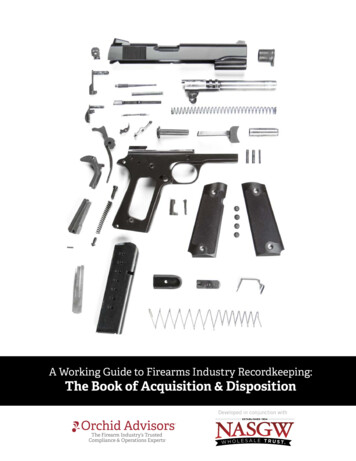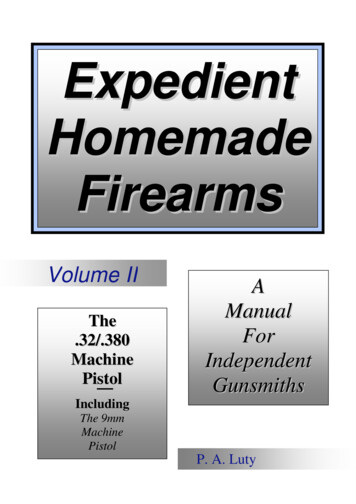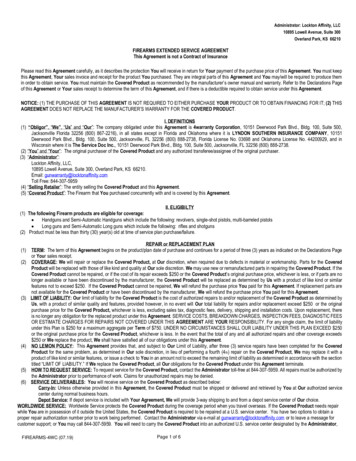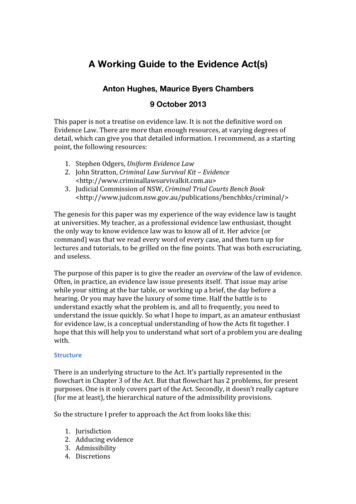
Transcription
A Working Guide to Firearms Industry Recordkeeping:OrchidThe Bookof Acquisition & DispositionAdvisors The Firearm Industry’s TrustedCompliance & Operations Experts Developed in conjunction with The Firearm Industry’s TrustedCompliance & Operations Experts
ContentsPART ONE:Understanding the Recordkeeping RegulationsA&D Accuracy is the Cornerstone of Compliance. / 4The Book of Acquisitions and Dispositions – Purpose and Structure / 5PART TWO:Evaluating Electronic SolutionsIntegrating the Rules with the Features / 13Federal Regulation Surrounding Electronic A&D Records / 13Should I Stay Or Should I Go [Electronic]? / 15The Traditional “Bound Book” / 16Electronic A&D Software Solutions – General Introduction / 17Electronic A&D Software Solutions – Eight Core Features to Consider / 17Final Thoughts / 20DisclaimerBy using this material, you agree that Orchid Advisors shall not be liable for any damages whatsoever.Orchid Advisors makes no representation as to the completeness nor legal interpretation of the contentin its licensed materials. This should be used as an operational guide to enhance awarenessand do not replace your responsibility for reading and complying with the law.
PART ONE:Understanding the RecordkeepingRegulationsWhy Are We Here?The regulations regarding recordkeeping, accuracy and compliance apply equally toall federal licensees, whether you are a small, one-person gunsmith, a mom-and-popfirearms retailer or a major manufacturer or distributor of firearms. While a majority oflarge manufacturers, distributors and retailers use custom Acquisition and Disposition(A&D) software, smaller FFLs tend to use off the shelf products ranging from pen-andpaper solutions to electronic recordkeeping tools. As we will discover, A&D accuracy isthe cornerstone for successfully navigating the regulatory landscape. An existing licensee with a legacy, home grown A&D system or a new startup may not have the capital orinfrastructure to implement a fully integrated, customized A&D recordkeeping suite, despite being held to the same regulatory standard. We hope that this guide will highlighttwo critically-important, yet extremely diverse concepts: Requirements for compliant recordkeeping; and Points to consider when leveraging technology to achievecompliant recordkeeping.In a few paragraphs, we will discuss how to utilize your regulatory requirements to define your recordkeeping success. Understanding the regulatory recordkeeping requirements are critical in your evaluation of off-the-shelf solutions or establishing a do-ityourself recordkeeping processes.3
A&D Accuracy is the Cornerstoneof Compliance.Inspection Priorities Can Define Your Success and Risk FactorsA licensee’s Book of Acquisitions and Dispositions can be viewed as the foundation foryour annual compliance inspection. Goals with respect to annual compliance inspections are discussed above, but include:1. Ensuring the licensee is maintaining accurate required forms (e.g., Form 4473;Form 3; Form 4; Form 5; Form 9; Theft, Loss or Missing Inventory Reports; Reports of Multiple Sale, etc.);2. Ensuring the licensee is maintaining an accurate Book of Acquisitionsand Dispositions;3. Maintaining the traceability of certain firearms, including where they were acquired from and to whom they were disposed;4. Disposition reports (including reports of multiple sale) which may lead to thediscovery of illegal firearms diversion and trafficking.Understand An Inspector’s Goals to Define Your Success and RisksOne of the best ways to ensure the demonstrable accuracy of a licensee’s records duringan annual compliance inspection than a complete bi-directional match between onhand inventory and the A&D Book, and supporting documentation (when required) fordisposed firearms.As you can see, the top focuses during the inspection process all center on information that is initially contained in three major sources: (a) Inventory on-hand; (b) A&DRecords; and (c) supporting documentation and required forms. For Title I firearms(and even to a degree Title II firearms), an investigator will need a starting point fromwhich to conduct their inspection. This starting point is the licensee’s A&D Book. Theaccuracy of these records can make or break the success of an inspection with respectto verification of inventory and supporting required forms, as this information will bevalidated against information contained in the A&D Book.A&D accuracy is so critical to the inspection process that an important first step ofmost inspections will be for the assigned IOI to conduct a bi-directional inventory of thelicensee’s books and physical inventory. Although inspections may be conducted withslight variation, in practice, the process is as follows:1. All physical firearms on the licensed premises and any off-site storage are compared to the A&D Book to ensure that all physical inventory is acquired; and2. All open entries in the A&D Book are compared to physical inventory to verifythere is a physical firearm for each open entry to ensure that no inventory is lost,stolen or unaccounted for.4
Even after the inventory portion of the annual compliance inspection is complete, theA&D Book will still play a central role in the remainder of the inspection, as closed entries (dispositions) will be reviewed against other required forms (Form 4473, Reportsof Multiple Sale, Form 3/4/5/9 for NFA dispositions or Missing Inventory/Theft Lossreports).The Book of Acquisitions and Dispositions– Purpose and StructureWhat is the A&D Book?At its core, the Book of Acquisition and Dispositions (or A&D Book, Bound Book, orsimply “the Book”) is so named because, in its most basic form, consists of sheets ofpaper bound together to prevent tampering or removing or inserting record entries andcontains records in accordance with ATF regulations. Historically, these records werekept on paper, but many business operations (both large and small) utilize an electronicversion for purposes of efficiency. Additionally, electronic recordkeeping software oftencontains logic that includes built-in data validation features.The purpose of the Book of Acquisition and Disposition is fairly simple; it is a registerthat tracks the movement of a firearm through a licensed facility by the incoming andoutgoing entries in the book. If, for any reason, a law enforcement agency needs totrace a firearm, they can do so by following the trail created by the transfers recorded inyour Book. The A&D Book is a cornerstone of the ATF’s tracing of firearms, and ensuring it is kept in a timely and accurate manner is a paramount concern to the industry’sregulators.Every time a firm acquires a firearm, the FFL records acquisitions in its A&D Book,citing important and required information, such as the serial number and a generaldescription of the firearm, date of the transaction and where it was acquired from. Likewise, every time a firearm is disposed of, similar information must be recorded. The federal requirements for the information captured and the appropriate formats is discussedin greater detail, below.Acquisition vs. Disposition vs. NeitherIn order to keep accurate records, the licenseemust first understand what information must becaptured, and what types of transactions mustbe recorded in the A&D Record. While the belowexamples do not take the place of the regulations,they should directionally guide you when reading pertinent laws. Note that the timing of theseentries should be made in accordance with thespecific rules of ATF Ruling 2013-5 or any Rulingthat supersedes it.5
AcquisitionsBusiness ProcessesSystemsAn acquisition occurs when a licensee takes possession of (or finds itself in possessionof) a firearm which it did not have before, or discovers that it is in possession of a firearm for which no prior regulatory records exist. Examples of when to acquire a firearmin your A&D Book include: At the point of firearm serialization (i.e., when it is created and marked in accordance with regulatory timing parameters); Receipt of firearm from a licensee or non-licensee when it has been formallytransferred to you (see regulated definition of a “transfer”); A to-be-repaired firearm that stays overnight in your facility; A firearm delivered for sale or consignment that stays overnight in your facility; When you “find” a firearm that was previously reported as scrapped (i.e., destroyed), stolen or lost.DispositionsCompliance ProcessesA disposition is the opposite of an acquisition. A disposition occurs when a firearmleaves the possession of a licensee, or discovers that it is not in possession of a firearmfor which no a regulatory record exists. Examples of when to dispose a firearm in yourA&D Book include: When you are unable to locate a firearm and have formally reported it asa Theft or Loss to the ATF; Firearm destruction (or scrap); Normal transfers to another licensee or non-licensee.Special Circumstances – Simultaneous Acquisitions & DispositionsAs you may know by now, firearms come in many forms. For example, the serializedcomponent of a rifle is the receiver. When a receiver is assembled into a rifle, or disassembled back to a receiver, it is technically changing form (per ATF Ruling 2012-1).Such changes in form have different identities (as defined by the regulations), andrequire the creation of a new record to reflect the new configuration of the firearm.Therefore, changes in form will result in a self-disposition (e.g., recording a dispositionto the licensee of a firearm in its former configuration, despite the firearm not leavingthe licensed premises) and self-acquisition (e.g., recording an acquisition by the licensee of a firearm in its new configuration which is already on the licensed premises) thatis recorded in the Book.Neither Acquisitions nor DispositionsCertain transactions can appear to meet the above definitions of “Acquisition” or “Disposition”, but are in fact, neither. The following transactions are not recorded in theA&D Book as acquisitions or dispositions: Temporary assignments to employees for bona fide business reasons as defined inATF Ruling 2010-1 (and firearms returned by the employee which were previouslytemporarily assigned);6
Movements to an offsite warehouse that has legally been approved as part of anFFL per the regulations; Movements inside of a facility to change its storage location; Changing the value of a manufactured or purchased part; Change in part number, Stock Keeping Unit (SKU) or material number (unless theATF characteristics also change).Note that some of these transactions would appear to warrant a “disposition “, however, if you understand how regulators view each of these transactions from a traceabilityperspective, it becomes more clear why each is not a disposition. Temporary assignments to employees for a bona-fide business purposes areviewed as still being in the custody and control of the licensee, and thereforeshould not be disposed (the firearm can still be traced to the licensee); Approved offsite storage locations are viewed as an extension of the licensedpremises and are therefore still in the custody and control of the licensee; Internal movements inside the licensed premises are still retained bythe licensee and; Changes in financial value, part number, material number or SKU do not changethe regulated physical characteristics of a firearm and they remain in possessionof the licensee.Other Special Circumstances – Timing and Circumstances DetermineWhether an Acquisition or Disposition Escorted Company Firearms: Firearms leaving or entering the premises of anFFL while under the escort of an employee from that FFL for bona fide businesspurposes (ATF Ruling 2010-1) are considered “Temporary Assignments” and donot constitute an acquisition or disposition. This might happen, for instance, ifa third party sends one of their employees to escort (fully under their control) afirearm while it is being camo coated at another business’ facility. However, if theemployee doesn’t maintain possession (i.e., control) of the firearm, or if it staysovernight out of their control, it will become an acquisition of that other facilityand a disposition in yours. Personal Firearms: If an employee brought his or her firearm to work for a fewhours, and, it was physically segregated (e.g., remaining under their control andideally marked as such), an acquisition or disposition would not be required. However, if the employee fails to retain control, and comingles it with other companyassets for an extended period of time, the ATF would argue that it was acquired(thus requiring an A&D acquisition entry) and require a NICS background check,4473, and a formal disposition record upon the return of thatasset to the employee.Clear as mud? Very good. Let’s take a look at how the Bound Book is laid out.Layout of the Bound BookThe bound book itself is a multi-page book comprised of many formatted, lined pages.Each firearm has one or many horizontal rows in your bound book (or electronic coun-7
terpart). The information in each row is divided into three sections – information aboutthe firearm, information about the party you acquired it from, and information about theparty you disposed it to.The following image is a sample manufacturing FFL bound book. The layout and requirements vary by FFL type as provided in Sections 478 and 479 of the regulations.Sample Manufacturing A&D Book(Note that the regulated form varies depending on the type of FFL held by the licensee;please consult the regulations for the regulatory requirements)Description of a FirearmDescription of eName andAddress orLicense No.DispositionDateNameAddress orLicensee. No. ifLicensee, or Form4473 SN if Form4473 FiledAn example of a Manufacturing or Dealer FFL A&D bound book page. (Source: Orchid Advisors)The first set of information recorded in the bound book will be the regulated informati
licensee’s books and physical inventory. Although inspections may be conducted with slight variation, in practice, the process is as follows: 1. All physical firearms on the licensed premises and any off-site storage are com-pared to the A&D Book to ensure that all physical inventory is acquired; and 2. All open entries in the A&D Book are compared to physical inventory to verifyFile Size: 398KBPage Count: 21











